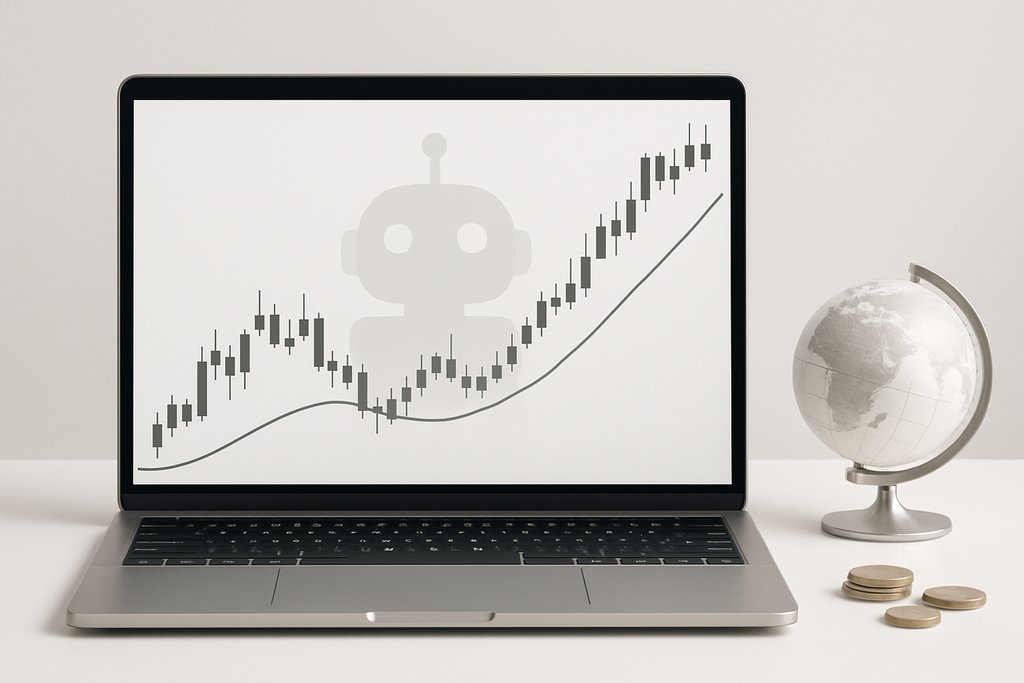Currency Trading Bot: Build, Backtest, Automate FX Strategy
Build a currency trading bot to automate FX strategies without code. Scan markets 24/5, backtest rules, execute fast, and manage risk on EUR/USD and GBP/USD.

If you are searching for currency trading bot, you probably want a way to watch the 24 hour FX market without missing opportunities or letting emotions derail your plan. Currencies move on prices, indicators, central bank decisions, macroeconomic data, and even headlines. No single human can track it all in real time. A well designed currency trading bot can transform your idea into a consistent process that scans the market, acts instantly, and manages risk the moment your conditions are met.
What is a currency trading bot
A currency trading bot is an automated system that monitors foreign exchange pairs like EUR/USD, GBP/USD, and USD/JPY, then executes trades based on predefined rules. Those rules can be simple, such as a moving average crossover, or complex, such as a multi timeframe strategy that waits for RSI to shift out of overbought while MACD turns bearish and price breaks a swing low. In practice, the bot continuously ingests price data, computes indicators, evaluates conditions, and sends orders to your broker when your logic is satisfied.
Think of it as your rule based assistant for forex. You tell it exactly what to look for and how to react. It never gets tired, never second guesses, and operates the same way at 2 AM as it does at 2 PM. If you need a refresher on a popular indicator, learn how the RSI indicator works and how traders apply it to FX.
How a currency trading bot works
Under the hood, every forex trading bot follows a loop that resembles a disciplined trader’s checklist. It connects to market data, computes signals, applies risk controls, and uses an execution path to place and manage orders.
- Data and signals: The bot pulls price quotes, ticks, or candles, calculates indicators such as RSI and MACD, and assesses patterns like breakouts or divergences. See RSI basics on Investopedia and MACD explanation.
- Rules and state: It checks whether your entry and exit rules are currently true, tracks open positions, and maintains state across timeframes.
- Risk management: It sizes positions, places stop losses and take profits, and enforces constraints such as maximum position count or daily loss limits.
- Execution and routing: It triggers market, limit, or stop orders and adjusts them as your logic demands. Slippage, latency, and spread matter in FX. The bot should handle partial fills, cancellations, and trailing stops reliably.
- Monitoring and logs: It records each event and provides metrics like win rate, expectancy, drawdown, and Sharpe ratio so you can iterate.
Obside significantly simplifies this flow. You describe what you want in plain language through Obside Copilot, for example “Buy EUR/USD when the 50 period moving average crosses above the 200 period moving average on the 1 hour chart, then set a stop loss 1 ATR below the entry and a take profit at 2 ATR.” Obside translates your words into a concrete bot, backtests it in seconds, and runs it automatically with your connected brokers and exchanges.

Why traders use a currency trading bot for FX markets
The foreign exchange market is open five days a week around the clock. Liquidity and volatility can spike when the London and New York sessions overlap, and major moves often occur during macro releases like CPI, NFP, or interest rate decisions. A currency trading bot is an advantage because it is always on, consistent, and fast.
Traders want to eliminate impulsive decisions and enforce rules that have been tested. They want to catch opportunities that last minutes rather than hours, and they want to react to events faster than manual clicks allow. With platforms like Obside, you can even make bots respond to news or macroeconomic data, such as “Sell EUR/USD if the ECB hikes by more than 50 bps and volatility spikes,” or “Flatten all FX positions if the DXY jumps 1.5 percent in ten minutes.” For background, review Investopedia’s forex overview and a broader history on Wikipedia’s foreign exchange market page.
Step by step: building a currency trading bot with Obside
There are many ways to build an FX bot, from coding a Python script to using a rule builder in a platform. Obside makes this accessible without code. Here is a practical path you can follow.
Start with an idea. Define the pairs and timeframes you care about, and articulate your edge in plain language. For example, you might believe EUR/USD has reliable momentum after a London breakout, or that USD/JPY mean reverts after extreme RSI readings.
Translate your idea into rules. Using Obside Copilot, describe your entry and exit logic as you would to a fellow trader. You can combine prices, indicators, news, and macro data. Examples include:
- “Alert me if RSI crosses 70 on EUR/USD and MACD turns bearish” then “Open a short position with a stop loss above the recent swing high and a take profit at the next support.”
- “Buy if GBP/USD breaks yesterday’s high during the London session, volume is above average, and the 20 period EMA is rising.”
- “Close positions and pause trading for one hour if spreads widen beyond 3 pips.”
Backtest the rules. Obside’s ultra fast engine runs through years of data to compute metrics like profit factor, Sharpe, maximum drawdown, average trade duration, and sensitivity to costs. Use out of sample testing and walk forward analysis to avoid overfitting. If performance is only strong in one narrow regime, revisit your logic. For process guidance, see our backtesting software guide.
Paper trade to validate execution and behavior. Ensure your currency trading bot handles gaps, spikes, session changes, and news events as expected. Confirm that stop losses and trailing stops behave correctly across volatile ticks.
Connect your broker and go live. Set position size per trade, daily risk limits, and protections like circuit breakers. Obside can manage entire portfolios based on your rules, including allocations across multiple currency pairs and correlated assets.
Monitor and iterate. A good FX bot evolves. Review logs, drill into losers, and look for systematic issues such as latency sensitive entries or spreads that undermine your edge. Adjust your rules and retest. If your focus is FX, use the Forex backtesting guide to validate parameters.
Examples you can run today
Momentum breakout on EUR/USD. A classic approach is to buy when price breaks above a recent range with confirming indicators. In Obside Copilot you can write: “On the 15 minute chart, buy EUR/USD when price closes above the 20 period high, the 14 period RSI is between 50 and 65, and the MACD histogram is rising. Place the stop loss at the low of the day and take profit at 1.5 times risk.” Backtest and see how this performs in London versus New York sessions.
Mean reversion on GBP/USD. If you prefer fades, “Short GBP/USD when RSI climbs above 75 and price is 1 percent above the 50 period moving average on the 30 minute chart. Exit on an RSI cross below 50 or at a 0.8 percent profit, whichever comes first.”
Multi timeframe trend following on USD/JPY. “When the Supertrend becomes bullish on the 2 hour chart, if RSI is not overbought and the Supertrend on the 8 hour chart is also bullish, then buy. For selling, reverse the logic. Also place a trailing stop loss at 5 ATR on the 2 hour chart. Close the position if the Supertrend on the 2 hour chart changes direction.” Obside can implement this exact rule set and manage the trailing logic automatically.
Event driven logic. “Flatten all FX positions if the S&P 500 drops by 10 percent,” or “Buy oil when a hurricane hits then hedge CAD/USD exposure accordingly,” or “Sell EUR/USD if new tariffs are announced.” Obside can trigger actions from conditions tied to prices, indicators, news, or macroeconomic data in real time.
Backtesting and performance validation
Backtesting is the difference between a hope and a plan.
A currency trading bot should only go live after you have subjected it to objective tests. Start with clean data, a variety of timeframes, and realistic costs. Include spreads, slippage, and occasional gaps. If your broker offers variable spreads around news, reflect that in your model or consider pausing the bot during extreme releases.
Use out of sample tests. Optimize parameters on one period, then validate on a separate period. Walk forward analysis reduces the risk that you are fitting noise. If your bot fails on fresh data, it may be reliant on conditions that no longer exist.
Interpret metrics properly. Profit factor above 1.3 can be a good sign for intraday FX strategies, but it depends on trade frequency and costs. Look at maximum drawdown relative to average monthly return. A Sharpe ratio above 1 can indicate a more desirable equity curve, but review win rate and expectancy too. Expectancy tells you average profit per trade relative to loss per trade, which is crucial when spreads are significant.
Stress test execution. Examine behavior during high volatility and liquidity holes. If your entries trigger exactly when spreads widen, consider adding a spread filter or volume condition. If trailing stops are repeatedly hit on noise, widen the trail or combine ATR multiples with structure based stops.
Key benefits of a currency trading bot
- Monitor markets 24/5 with consistent rules
- Execute instantly without emotional bias
- Combine indicators with event triggers
- Backtest fast and iterate confidently
The clear benefits include speed, consistency, and discipline. The bot acts the same way each time your conditions are met. It does not chase, it does not fear, and it can watch dozens of pairs at once. It is ideal for combining technical signals with event triggers, which is often where FX edges live.
There are considerations you should respect. Overfitting is a common trap. If you layer too many filters until the backtest looks perfect, you might have a brittle strategy that fails in production. Data quality matters. Latency, spreads, and order routing can change your outcome relative to a theoretical model. Regime changes are real. A strategy that thrives when central banks are hiking can stumble when policy pauses. Bots need monitoring. Automation removes manual clicks but you still own the results.
Obside for professional grade currency trading bots
Obside is a financial automation SaaS platform that turns your ideas into market actions. You simply chat with Obside Copilot, describing in plain language what you want to do. The platform can create smart alerts, trigger automatic orders, or manage entire FX portfolios based on your own rules. Whether your conditions are tied to RSI on EUR/USD, MACD on GBP/USD, central bank statements, or CPI surprises, Obside lets you react in real time.
Validation is fast. You can backtest in seconds, evaluate results, and deploy when ready. Execution is integrated through your connected brokers and exchanges. You can set granular risk controls such as daily stops, per trade maximum loss, and portfolio level constraints. For discovery, explore our best trading bot guide or the trading automation overview.
If you are ready to experiment, you can head to the platform at beta.obside.com and create a bot in minutes. If you want to join and test drive, register at beta.obside.com/register.
Conclusion: put your currency trading bot to work
The search for currency trading bot is the search for consistency under pressure. FX rewards those who can filter noise, react quickly, and manage risk without hesitation. Start by writing down your edge, translate it into rules, and backtest until you trust the logic. Paper trade to validate behavior, then deploy with sensible protections. Automation is not a magic fix, but it is a reliable way to ensure your plan is executed without emotion.
Obside lets you do all of this without code. Talk to the Copilot about your EUR/USD strategy, your GBP/USD breakout, or your USD/JPY trend filter. Run backtests in seconds, then go live with your broker. If you prefer to begin with alerts, create a few, such as “Alert me if Bitcoin rises above 150000 dollars and daily volume doubles,” or “Alert me if Apple announces a new product.” When you are ready, convert those alerts to actions and full strategies.
Actionable next steps. Write one bot idea today and test it. Try a momentum breakout on EUR/USD with structured stops and a trailing take profit. Add a spread filter to improve entries. Use Obside to iterate fast and deploy when the numbers make sense.
Want to try it now? Create your account to build your first FX bot in minutes.
FAQs
What is a currency trading bot and how does it differ from manual trading
A currency trading bot is an automated system that executes your rules without manual input. It monitors FX pairs, evaluates signals, and sends orders as soon as your conditions are met. Manual trading relies on your attention and subjective judgment. A bot enforces discipline and speed, which is critical in the 24 hour forex market.
Do I need to code to build a currency trading bot
No. With Obside you can describe your strategy in plain language, such as “Buy EUR/USD when the 50 SMA crosses above the 200 SMA on the 1 hour chart, stop at 1 ATR, take profit at 2 ATR” and the platform translates that into a working bot. You can backtest, paper trade, and deploy without writing code.
Can a currency trading bot trade news and macroeconomic events
Yes. Many FX moves are event driven. Obside can trigger alerts and actions based on news and macro data, for example “Sell EUR/USD if new tariffs are announced,” or “Rebalance allocations if volatility spikes after CPI.” For research workflows, visit the Trading News Hub.
How do I avoid overfitting my FX bot
Use out of sample testing and walk forward validation. Keep your rules simple and robust. Stress test across different regimes, sessions, and cost assumptions. If a parameter change causes performance to collapse, your logic may be fragile. Iterate and prefer edges that make economic sense.
Which indicators work best for a currency trading bot
There is no one best indicator. Common choices in FX include moving averages for trend, RSI for momentum extremes, ATR for volatility, and MACD for confirmation. The value comes from how you combine them with price structure, session context, and events. Backtest thoroughly before going live. Investopedia offers basics on common indicators, such as RSI and MACD.






